+ Open data
Open data
- Basic information
Basic information
| Entry | Database: PDB / ID: 2ffd | |||||||||
|---|---|---|---|---|---|---|---|---|---|---|
| Title | Fibrinogen Fragment D with "A" knob peptide mimic GPRVVE | |||||||||
 Components Components |
| |||||||||
 Keywords Keywords | BLOOD CLOTTING / Complex of fibrinogen with "A" site mimic GPRVVE in both "A" and "B" sites | |||||||||
| Function / homology |  Function and homology information Function and homology informationblood coagulation, common pathway / induction of bacterial agglutination / fibrinogen complex / Regulation of TLR by endogenous ligand / platelet alpha granule / blood coagulation, fibrin clot formation / cellular response to leptin stimulus / MyD88 deficiency (TLR2/4) / positive regulation of heterotypic cell-cell adhesion / IRAK4 deficiency (TLR2/4) ...blood coagulation, common pathway / induction of bacterial agglutination / fibrinogen complex / Regulation of TLR by endogenous ligand / platelet alpha granule / blood coagulation, fibrin clot formation / cellular response to leptin stimulus / MyD88 deficiency (TLR2/4) / positive regulation of heterotypic cell-cell adhesion / IRAK4 deficiency (TLR2/4) / extracellular matrix structural constituent / MyD88:MAL(TIRAP) cascade initiated on plasma membrane / plasminogen activation / p130Cas linkage to MAPK signaling for integrins / positive regulation of peptide hormone secretion / positive regulation of vasoconstriction / GRB2:SOS provides linkage to MAPK signaling for Integrins / protein secretion / positive regulation of exocytosis / protein polymerization / cellular response to interleukin-1 / Integrin cell surface interactions / Common Pathway of Fibrin Clot Formation / negative regulation of endothelial cell apoptotic process / negative regulation of extrinsic apoptotic signaling pathway via death domain receptors / fibrinolysis / cell adhesion molecule binding / Integrin signaling / positive regulation of substrate adhesion-dependent cell spreading / platelet alpha granule lumen / cell-matrix adhesion / positive regulation of protein secretion / Post-translational protein phosphorylation / Signaling by high-kinase activity BRAF mutants / MAP2K and MAPK activation / response to calcium ion / platelet aggregation / Regulation of Insulin-like Growth Factor (IGF) transport and uptake by Insulin-like Growth Factor Binding Proteins (IGFBPs) / Signaling by RAF1 mutants / Signaling by moderate kinase activity BRAF mutants / Paradoxical activation of RAF signaling by kinase inactive BRAF / Signaling downstream of RAS mutants / Signaling by BRAF and RAF1 fusions / Platelet degranulation / extracellular vesicle / protein-folding chaperone binding / : / ER-Phagosome pathway / protein-containing complex assembly / cell cortex / protein-macromolecule adaptor activity / blood microparticle / adaptive immune response / positive regulation of ERK1 and ERK2 cascade / endoplasmic reticulum lumen / Amyloid fiber formation / signaling receptor binding / innate immune response / external side of plasma membrane / synapse / structural molecule activity / cell surface / endoplasmic reticulum / extracellular space / extracellular exosome / extracellular region / metal ion binding / plasma membrane Similarity search - Function | |||||||||
| Biological species |  Homo sapiens (human) Homo sapiens (human) | |||||||||
| Method |  X-RAY DIFFRACTION / X-RAY DIFFRACTION /  MOLECULAR REPLACEMENT / Resolution: 2.89 Å MOLECULAR REPLACEMENT / Resolution: 2.89 Å | |||||||||
 Authors Authors | Betts, L. | |||||||||
 Citation Citation |  Journal: THROMB.HAEMOST. / Year: 2006 Journal: THROMB.HAEMOST. / Year: 2006Title: The structure of fibrinogen fragment D with the 'A' knob peptide GPRVVE. Authors: Betts, L. / Merenbloom, B.K. / Lord, S.T. | |||||||||
| History |
|
- Structure visualization
Structure visualization
| Structure viewer | Molecule:  Molmil Molmil Jmol/JSmol Jmol/JSmol |
|---|
- Downloads & links
Downloads & links
- Download
Download
| PDBx/mmCIF format |  2ffd.cif.gz 2ffd.cif.gz | 277.4 KB | Display |  PDBx/mmCIF format PDBx/mmCIF format |
|---|---|---|---|---|
| PDB format |  pdb2ffd.ent.gz pdb2ffd.ent.gz | 221.7 KB | Display |  PDB format PDB format |
| PDBx/mmJSON format |  2ffd.json.gz 2ffd.json.gz | Tree view |  PDBx/mmJSON format PDBx/mmJSON format | |
| Others |  Other downloads Other downloads |
-Validation report
| Summary document |  2ffd_validation.pdf.gz 2ffd_validation.pdf.gz | 1.1 MB | Display |  wwPDB validaton report wwPDB validaton report |
|---|---|---|---|---|
| Full document |  2ffd_full_validation.pdf.gz 2ffd_full_validation.pdf.gz | 1.1 MB | Display | |
| Data in XML |  2ffd_validation.xml.gz 2ffd_validation.xml.gz | 50.3 KB | Display | |
| Data in CIF |  2ffd_validation.cif.gz 2ffd_validation.cif.gz | 69.7 KB | Display | |
| Arichive directory |  https://data.pdbj.org/pub/pdb/validation_reports/ff/2ffd https://data.pdbj.org/pub/pdb/validation_reports/ff/2ffd ftp://data.pdbj.org/pub/pdb/validation_reports/ff/2ffd ftp://data.pdbj.org/pub/pdb/validation_reports/ff/2ffd | HTTPS FTP |
-Related structure data
| Related structure data |  1ltjS S: Starting model for refinement |
|---|---|
| Similar structure data |
- Links
Links
- Assembly
Assembly
| Deposited unit | 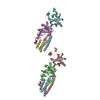
| ||||||||
|---|---|---|---|---|---|---|---|---|---|
| 1 | 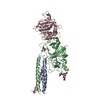
| ||||||||
| 2 | 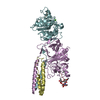
| ||||||||
| Unit cell |
|
- Components
Components
-Protein , 3 types, 6 molecules ADBECF
| #1: Protein | Mass: 7747.030 Da / Num. of mol.: 2 / Fragment: residues 145-210 Source method: isolated from a genetically manipulated source Source: (gene. exp.)  Homo sapiens (human) / Gene: FGA / Cell line (production host): ovary cells / Production host: Homo sapiens (human) / Gene: FGA / Cell line (production host): ovary cells / Production host:  #2: Protein | Mass: 35940.215 Da / Num. of mol.: 2 / Fragment: residues 179-491 Source method: isolated from a genetically manipulated source Source: (gene. exp.)  Homo sapiens (human) / Gene: FGB / Cell line (production host): ovary cells / Production host: Homo sapiens (human) / Gene: FGB / Cell line (production host): ovary cells / Production host:  #3: Protein | Mass: 35217.992 Da / Num. of mol.: 2 / Fragment: residues 122-432 Source method: isolated from a genetically manipulated source Source: (gene. exp.)  Homo sapiens (human) / Gene: FGG / Cell line (production host): ovary cells / Production host: Homo sapiens (human) / Gene: FGG / Cell line (production host): ovary cells / Production host:  |
|---|
-Protein/peptide / Sugars , 2 types, 6 molecules GHIJ
| #4: Protein/peptide | Mass: 656.751 Da / Num. of mol.: 4 / Source method: obtained synthetically / Details: synthetic construct #5: Polysaccharide | Source method: isolated from a genetically manipulated source |
|---|
-Non-polymers , 2 types, 235 molecules 


| #6: Chemical | ChemComp-CA / #7: Water | ChemComp-HOH / | |
|---|
-Details
| Has protein modification | Y |
|---|
-Experimental details
-Experiment
| Experiment | Method:  X-RAY DIFFRACTION / Number of used crystals: 1 X-RAY DIFFRACTION / Number of used crystals: 1 |
|---|
- Sample preparation
Sample preparation
| Crystal | Density Matthews: 3 Å3/Da / Density % sol: 59.04 % |
|---|---|
| Crystal grow | Temperature: 277 K / Method: vapor diffusion, sitting drop / pH: 8.5 Details: 10% PEG3350, 12.5 mM CaCl2, pH 8.5, VAPOR DIFFUSION, SITTING DROP, temperature 277K |
-Data collection
| Diffraction | Mean temperature: 100 K |
|---|---|
| Diffraction source | Source:  ROTATING ANODE / Type: RIGAKU RU300 / Wavelength: 1.5418 Å ROTATING ANODE / Type: RIGAKU RU300 / Wavelength: 1.5418 Å |
| Detector | Type: RIGAKU RAXIS IV / Detector: IMAGE PLATE / Date: Apr 10, 2004 / Details: Osmic Confocal Blue |
| Radiation | Monochromator: Osmic confocal Blue / Protocol: SINGLE WAVELENGTH / Monochromatic (M) / Laue (L): M / Scattering type: x-ray |
| Radiation wavelength | Wavelength: 1.5418 Å / Relative weight: 1 |
| Reflection | Resolution: 2.9→20 Å / Num. obs: 42946 / % possible obs: 98.4 % / Observed criterion σ(F): 0 / Observed criterion σ(I): 2 / Redundancy: 4 % / Biso Wilson estimate: 55.3 Å2 / Rmerge(I) obs: 0.162 / Χ2: 1.279 / Net I/σ(I): 8.6 |
| Reflection shell | Resolution: 2.9→3 Å / Redundancy: 3 % / Rmerge(I) obs: 0.5 / Mean I/σ(I) obs: 2.6 / Num. unique all: 4131 / Χ2: 1.187 / % possible all: 96.5 |
- Processing
Processing
| Software |
| |||||||||||||||||||||||||||||||||||||||||||||||||||||||||||||||||||||||||||||||||||||||||||||||
|---|---|---|---|---|---|---|---|---|---|---|---|---|---|---|---|---|---|---|---|---|---|---|---|---|---|---|---|---|---|---|---|---|---|---|---|---|---|---|---|---|---|---|---|---|---|---|---|---|---|---|---|---|---|---|---|---|---|---|---|---|---|---|---|---|---|---|---|---|---|---|---|---|---|---|---|---|---|---|---|---|---|---|---|---|---|---|---|---|---|---|---|---|---|---|---|---|
| Refinement | Method to determine structure:  MOLECULAR REPLACEMENT MOLECULAR REPLACEMENTStarting model: pdb entry 1LTJ Resolution: 2.89→20 Å / Cor.coef. Fo:Fc: 0.914 / Cor.coef. Fo:Fc free: 0.851 / SU B: 15.607 / SU ML: 0.293 / Cross valid method: THROUGHOUT / σ(F): 0 / ESU R Free: 0.411 / Stereochemistry target values: MAXIMUM LIKELIHOOD / Details: HYDROGENS HAVE BEEN ADDED IN THE RIDING POSITIONS
| |||||||||||||||||||||||||||||||||||||||||||||||||||||||||||||||||||||||||||||||||||||||||||||||
| Solvent computation | Ion probe radii: 0.8 Å / Shrinkage radii: 0.8 Å / VDW probe radii: 1.2 Å / Solvent model: MASK | |||||||||||||||||||||||||||||||||||||||||||||||||||||||||||||||||||||||||||||||||||||||||||||||
| Displacement parameters | Biso mean: 36.572 Å2
| |||||||||||||||||||||||||||||||||||||||||||||||||||||||||||||||||||||||||||||||||||||||||||||||
| Refinement step | Cycle: LAST / Resolution: 2.89→20 Å
| |||||||||||||||||||||||||||||||||||||||||||||||||||||||||||||||||||||||||||||||||||||||||||||||
| Refine LS restraints |
| |||||||||||||||||||||||||||||||||||||||||||||||||||||||||||||||||||||||||||||||||||||||||||||||
| LS refinement shell | Resolution: 2.895→2.97 Å / Total num. of bins used: 20
|
 Movie
Movie Controller
Controller





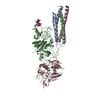
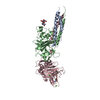

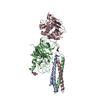
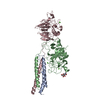
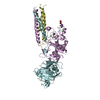


 PDBj
PDBj











